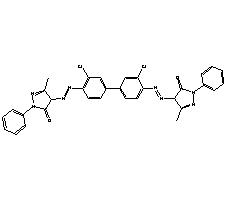Pigment Orange 13
| Product Name | PIGMENT ORANGE 13 |
| Synonyms | C.I.Pigment Orange 13; C.I.PO13; PO13; P.O.13 |
| C.I. | 21110 |
| CAS NO. | 3520-72-7 |
| EINECS | 222-530-3 |
| Molecular Weight | 623.49 |
| Molecular Formula | C32H24Cl2N8O2 |
| Density | 1.42g/cm3 |
| Color | Orange powder |
![]()
Molecular structure formula:

Fastness Properties of Pigment Orange 13:
| Light Fastness | 3-4 |
| Heat Resistance(℃) | 180 |
| Water Resistance | 4-5 |
| Oil Resistance | 5 |
| Acid Resistance | 4-5 |
| Alkali Resistance | 4-5 |
| Alcohol Resistance | 3-4 |
Main application: Water based ink, Offset ink, Solvent based ink, Plastic, Paint, Textile printing
We have various pigment grades and properties to meet different customers’ needs, please specify your application and requirements so that we can recommend accordingly. E-mail: sy@sypigment.com
Product Description of Pigment Orange 13:
Pigmnet Orange 13 is used for coloring of ink, plastic, rubber, pigment printing paste and cultural and educational supplies; the shade is similar to that of Pigment Orange 34, and the translucent specific surface area is 35-40m2/g (Irgalite Orange D specific surface area is 39m2/g); plastic PVC coloring is not recommended due to migration; Natural rubber is resistant to vulcanization and migration, so it is suitable for rubber coloring; detergent resistant, good water resistance, used for swimming articles, sponge, viscose fiber pulp, packaging ink and metal decorative paint coloring, heat resistance (200 ℃); and for rubber industry.
Pigment Orange 13 is an organic compound and an azo compound. It is a commercial orange pigment. It is also classified as a diarylide pigment, being derived from 3,3'-dichlorobenzidine. It is closely related to Pigment Orange 3, wherein the two phenyl groups are replaced by p-tolyl groups.
Pigment Orange 13 is coloristically very similar to Pigment Orange 34, but generally somewhat more yellow. Application of Pigment Orange 13 in polyolefins is limited. The pigment is very fast to detergents. It is also employed in viscous spin dyeing and in mass dyeing. The graphics industry, on the other hand, uses pigment orange 13 to an appreciable extent for packaging printing inks. Its fastness to light is average but the stability of pigmented prints to a number of organic solvents is excellent or almost perfect. Similarly, the prints are fast to paraffin, butter, and soap. They withstand heat very well and are stable up to 200°C. Pigment orange 13 thus lends itself to metal decor printing, provided its light-fastness suits the purpose. Likewise, its resistance to clear lacquer coatings and to sterilization is excellent.
TDS (Pigment Orange 13) MSDS (Pigment Orange 13)Synonyms
- Pigment Orange 13
- 4,4′-((3,3′-Dichloro-[1,1′-biphenyl]-4,4′-diyl)bis(diazene-2,1-diyl))bis(3-methyl-1-phenyl-1H-pyrazol-5(4H)-one)
- SCHEMBL2641824
- AKOS025311122
- AKOS030627473
- Pigment Orange 13; 4,4′-[(3,3′-Dichloro[1,1′-biphenyl]-4,4′-diyl)bis(azo)]bis[2,4-dihydro-5-methyl-2-phenyl-3H-pyrazol-3-one]
- C.I.21110
- P0596
- H10760
- W-109143
IUPAC Name: 4-[[2-chloro-4-[3-chloro-4-[(3-methyl-5-oxo-1-phenyl-4H-pyrazol-4-yl)diazenyl]phenyl]phenyl]diazenyl]-5-methyl-2-phenyl-4H-pyrazol-3-one
InChI: InChI=1S/C32H24Cl2N8O2/c1-19-29(31(43)41(39-19)23-9-5-3-6-10-23)37-35-27-15-13-21(17-25(27)33)22-14-16-28(26(34)18-22)36-38-30-20(2)40-42(32(30)44)24-11-7-4-8-12-24/h3-18,29-30H,1-2H3
InChIKey: HKYYDLYCGBDWSB-UHFFFAOYSA-N
Canonical SMILES: CC1=NN(C(=O)C1N=NC2=C(C=C(C=C2)C3=CC(=C(C=C3)N=NC4C(=NN(C4=O)C5=CC=CC=C5)C)Cl)Cl)C6=CC=CC=C6
| Property Name | Property Value |
| Molecular Weight | 623.5 |
| XLogP3-AA | 7.6 |
| Hydrogen Bond Donor Count | 0 |
| Hydrogen Bond Acceptor Count | 8 |
| Rotatable Bond Count | 7 |
| Exact Mass | 622.1399274 |
| Monoisotopic Mass | 622.1399274 |
| Topological Polar Surface Area | 115 Ų |
| Heavy Atom Count | 44 |
| Formal Charge | 0 |
| Complexity | 1090 |
| Isotope Atom Count | 0 |
| Defined Atom Stereocenter Count | 0 |
| Undefined Atom Stereocenter Count | 2 |
| Defined Bond Stereocenter Count | 0 |
| Undefined Bond Stereocenter Count | 0 |
| Covalently-Bonded Unit Count | 1 |
| Compound Is Canonicalized | Yes |






